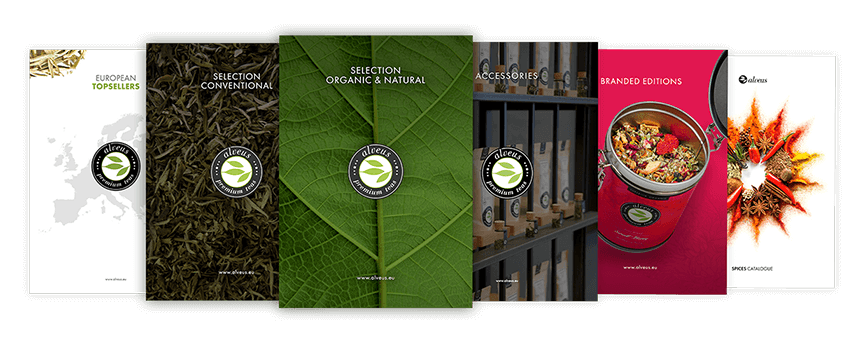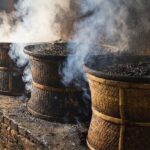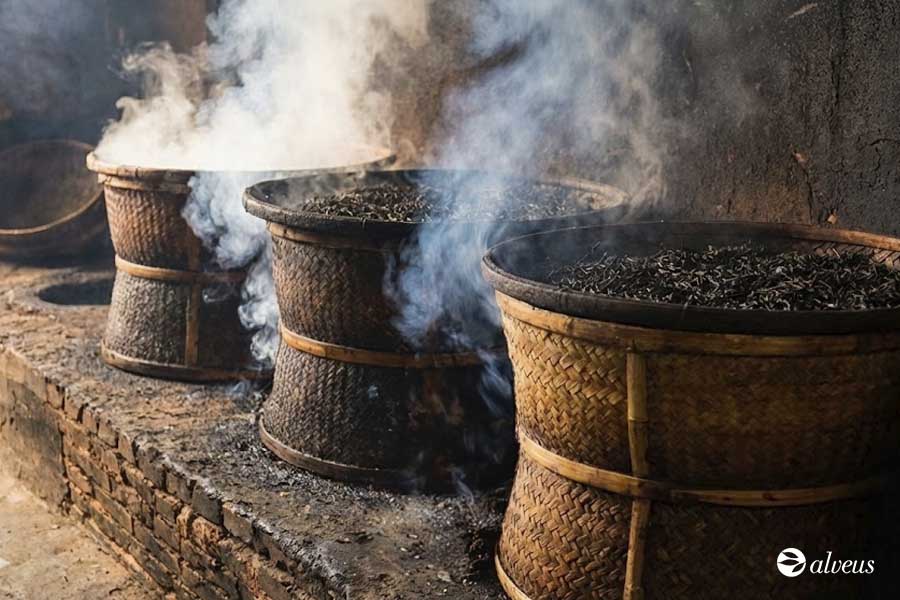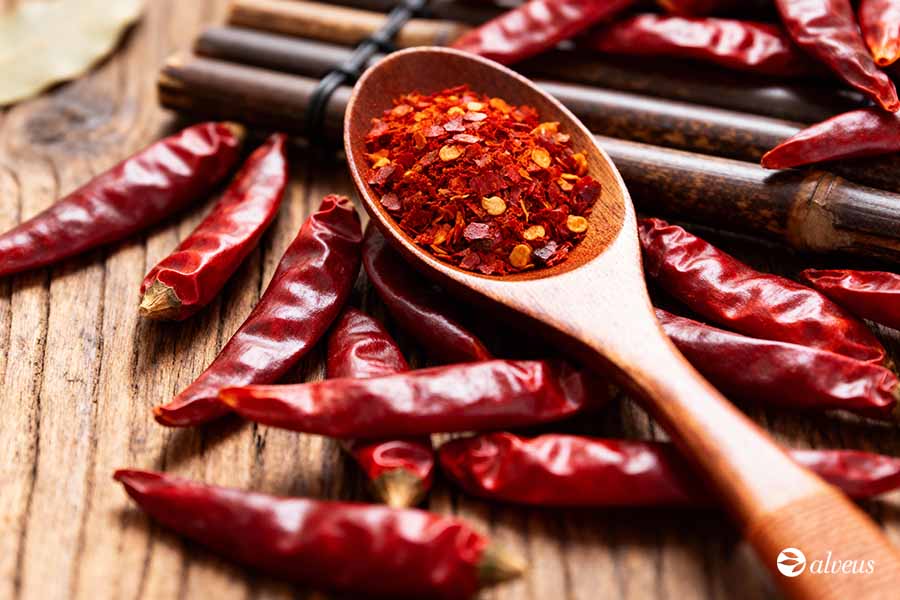In the world of spices and medicinal plants, few herbs hold a legacy as rich as Tulsi, the so-called holy basil.
For centuries, it has been venerated in India as a symbol of purity and protection, found in temples, homes, and daily rituals.
Today, its ancient prestige transcends borders, making it a botanical gem increasingly appreciated in the world of teas, infusions, and spices.
In this article, we’ll explore Tulsi from multiple perspectives: its origin and historical legacy, botanical characteristics and aromatic profile, as well as the different forms in which it is marketed.
We’ll also examine its current relevance in the market, offering practical insights for professionals and businesses wishing to incorporate this millenary herb into their catalogue strategically and distinctively.
What Is Tulsi?
Tulsi (Ocimum tenuiflorum or Ocimum sanctum) is an aromatic plant belonging to the Lamiaceae family, the same as culinary basil (Ocimum basilicum) and mint.
Its name in Sanskrit means “the incomparable” — a reflection of the cultural, spiritual, and medicinal value attributed to it for centuries in India.
Origin and History of the “Holy Basil”
Tulsi has a millenary history deeply connected with Ayurveda, India’s traditional system of medicine, as well as the spirituality of the region.
In Hindu mythology, it is associated with the goddess Lakshmi, symbol of prosperity, and with the god Vishnu, protector of life.
For centuries, this sacred herb has been used in rituals, offerings, and spiritual practices, as well as in households, where cultivating Tulsi in pots or small shrines carries both symbolic and practical meaning.
Beyond its cultural significance, Ayurvedic medicine recognises Tulsi as a tonic and purifying herb. Ancient texts describe its use to balance the body and mind and to support general well-being. This blend of spiritual relevance and medicinal functionality has made Tulsi a cultural and therapeutic icon in India.
Geographically, Tulsi is native to tropical and subtropical regions of South and Southeast Asia, particularly India and Nepal.

Current Production and Distribution
Today, India is responsible for more than 90% of global Tulsi production, both in dried leaves for infusions and in extracts used in supplements and cosmetics.
Its cultivation has also spread to other warm regions of the world, although on a smaller scale, including Thailand, Sri Lanka, Latin America, and parts of Africa, mainly for medicinal and commercial purposes.
The growing global interest in organic, natural, and wellness-related products has boosted demand for organic Tulsi, particularly in the European market, where it has become established as a premium ingredient in tea and herbal infusion catalogues.
Botanical Characteristics
This plant, regarded as medicinal, behaves as a perennial in tropical climates, while in temperate regions it is usually cultivated as an annual herb that can reach between 50 and 100 centimetres in height.
Its oval, serrated leaves are covered with fine hairs that release an intense, spicy aroma when rubbed. In summer, it produces small white or purple flowers grouped in spikes.
Three main varieties differ in morphology and aromatic composition: Rama (green), Krishna (purple), and Vana (wild).
Phytochemical Composition and Active Principles
From a phytochemical perspective, holy basil stands out for its complex profile of aromatic and antioxidant compounds. Its essential oil is rich in eugenol, a component also found in clove, which gives it warm and slightly spicy notes.
Other important compounds include:
- Flavonoids (such as apigenin and luteolin), associated with antioxidant activity.
Polyphenols, partly responsible for its characteristic flavour. - Triterpenic acids (such as ursolic acid), of interest in phytotherapeutic research.
- Saponins and other secondary metabolites contribute to its functional profile.
Several studies have explored the relationship between these compounds and potential balancing or anti-inflammatory effects, although their current use focuses mainly on natural wellness and aromatherapy.
Organoleptic Profile of Holy Basil
Talking about holy basil means delving into a complex and nuanced sensory profile.
Its aroma is intense, with a herbal and spicy base where notes of clove, basil, and mint predominate, supported by a fresh and slightly sweet background.
On the palate, Tulsi offers a persistent flavour with a warm initial sensation that evolves into a refreshing finish. This duality between the spicy and the balsamic explains its growing importance in the world of natural infusions and functional blends.
The organoleptic profile of Tulsi changes depending on the variety:
- Rama Tulsi (green): soft herbal notes with a sweet, rounded character.
- Krishna Tulsi (purple): more intense and spicy, with deep, warm undertones.
- Vana Tulsi (wild): fresh aroma with citrus hints, ideal for energising blends.
From a professional perspective, this aromatic profile positions Tulsi as a high-value ingredient for premium formulations, capable of bringing identity, balance, and sensory complexity to tea and infusion products.

Traditional and Current Uses
Traditionally, Tulsi has been attributed with the ability to balance vital energy, support bodily vitality, and promote mental clarity. It has also played a role in religious and domestic rituals, where cultivating the plant symbolises protection and well-being.
Parts of the Plant Used
The leaves are the most commonly used part, whether fresh or dried, as they contain the highest concentration of aroma and active compounds. The aerial parts of the plant are also used, harvested before flowering, to preserve their aromatic and phytochemical profile.
Less commonly, the flowers add delicate nuances to premium infusions and blends, while fresh juice is traditionally used in topical applications and homemade remedies.
Tulsi essential oil, obtained through steam distillation, is used in aromatherapy, natural cosmetics, and functional formulations.

Uses of Tulsi in Ayurvedic Medicine
In Ayurveda, Tulsi occupies a central place as a tonic and adaptogenic plant. It is believed to:
- Balance the doshas (Vata, Pitta, and Kapha), harmonising body and mind.
- Support resistance to stress and fatigue, promoting mental clarity and vitality.
- Form part of traditional herbal preparations, combined with plants such as ginger, cinnamon, or cardamom to promote purification and general well-being.
Versatile and deeply aromatic, Tulsi can be used in dried leaves, powder, or essential oil form to create herbal preparations, revitalising tonics, or cleansing rituals.
It has also become a valued ingredient in aromatherapy and natural skincare.
Its Ayurvedic heritage continues to inspire modern wellness practices, adapted into infusions, supplements, and holistic routines that preserve its spiritual essence.
Most Common Current Uses
Pure Infusions and Tulsi Tea
This is the most common presentation in the West, appreciated for its spicy aroma and balanced herbal profile.

*Premium quality Organic Tulsi herb, available in bulk for professional wholesale purchase from the Alveus B2B Shop.
Functional Blends and Herbal Mixes
Holy basil blends easily with green tea, black tea, rooibos, ginger, or cardamom, adding aromatic complexity and an exotic touch to premium blends.
Supplements and Dietary Products
This medicinal herb is used in natural supplements, capsules, and nutritional blends designed to support daily well-being.
Functional Beverages and Wellness Drinks
A growing trend combines the cultural value of Tulsi with the global interest in adaptogenic and natural ingredients.
Tulsi Essential Oil
Tulsi essential oil is widely used in aromatherapy and natural cosmetics for its intense fragrance and warm, spicy aroma profile.
The Potential of Tulsi as a Strategic Ingredient
Tulsi is more than just an aromatic plant. It represents tradition, spirituality, and Ayurveda, while establishing itself as a strategic ingredient in the global market for teas, herbal infusions, and spices.
Its unique sensory profile, together with its multiple formats (dried leaves, Tulsi powder, and Tulsi essential oil), allows it to be used in infusions, functional blends, and wellness products, offering distinctive and authentic experiences.
Its commercial versatility and cultural value make it an opportunity for brands, wholesalers, and businesses that aim to unite tradition and modernity, providing consumers with complete sensory experiences that combine well-being, nature, and authenticity.










